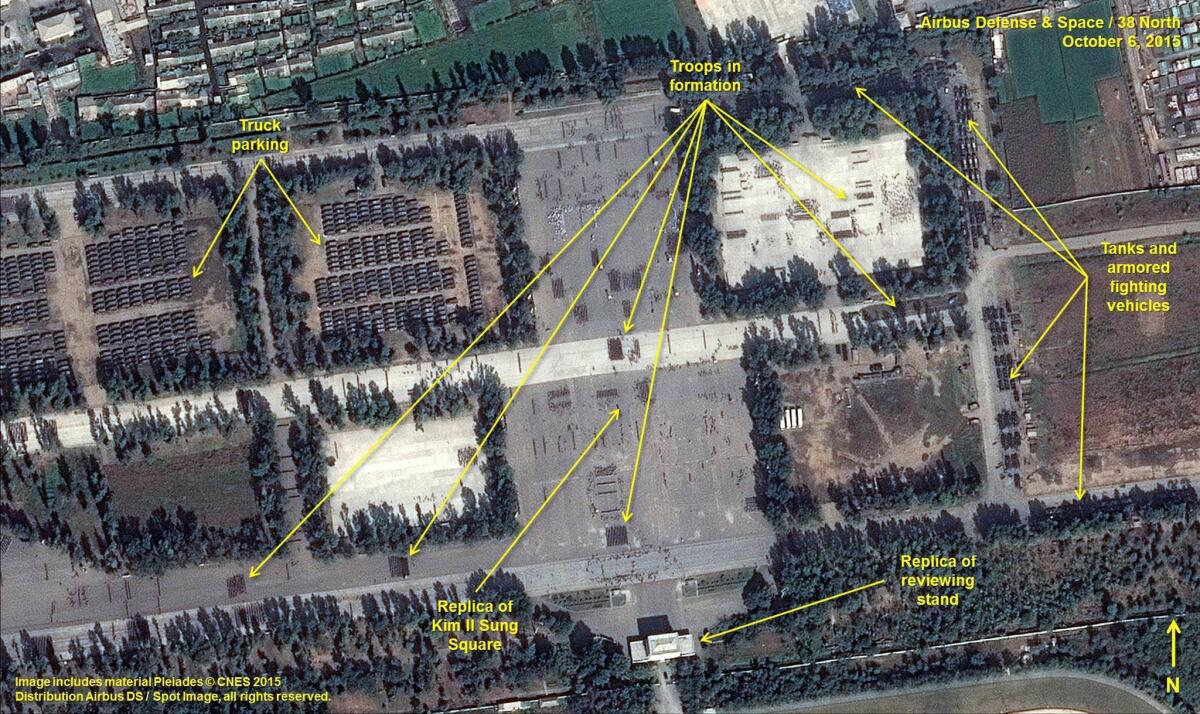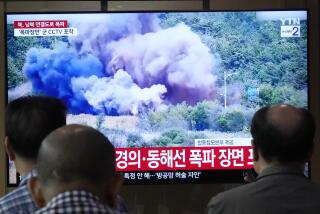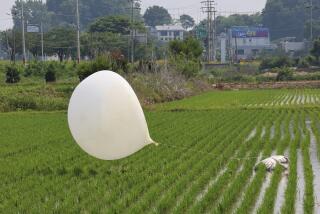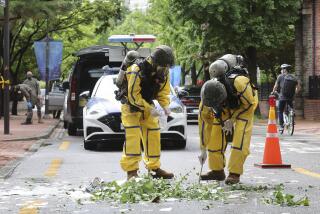North Korea sending a message with massive military parade

This handout image released Oct. 9 by the 38 North website shows North Korea has amassed hundreds of trucks, armored vehicles, troops and horses for the country’s giant military parade on Oct. 10.
Reporting from Seoul — North Korea, relatively small nation that it is, will do its best Saturday to convince the world — and particularly the United States — that it’s not to be trifled with.
The North plans an exceptionally large display of its military power to mark the 70th anniversary of the founding of the ruling Workers’ Party of Korea. Soldiers and citizens will gather in Pyongyang, the capital, for the main event: a parade featuring goose-stepping soldiers, ballistic missile launchers, long-range self-propelled guns and slogans celebrating the party’s power.
Pyongyang organizes carefully choreographed displays of military might to drum up patriotism and push the narrative that North Korea needs a strong military to withstand outside forces who wish it harm, analysts say.
“This large display is a way of demonstrating that North Korea is defying international pressure,” said Bruce Klingner, senior research fellow at the Heritage Foundation in Washington.
Public gatherings are planned in cities around the country, and Daily NK, a Seoul-based news website with sources in North Korea, reported this week that North Koreans were put to work cleaning and decorating for the occasion. They also were ordered to give money to local officials, ostensibly to chip in for the costs of the celebration, the website reported.
Saturday’s military parade is expected to be one of North Korea’s biggest. Satellite images released this week by 38 North, a North Korean affairs website affiliated with Johns Hopkins University, showed that organizers have been gathering troops and equipment for the parade at an airbase near Pyongyang for the past six months. By August, there were more than 500 tents, 600 trucks and 170 armored and military vehicles at the air base, 38 North reported.
In the long lead-up to the big day, experts have speculated that North Korea would launch a rocket. The U.S. and United Nations consider such events a veiled way of testing ballistic missile technology amid fears that Pyongyang could seek to mount a nuclear warhead on a missile.
North Korea has not conducted a nuclear test since its third in early 2013, leading to speculation over when the next test could come. Since then, North Korea has regularly issued strongly worded statements arguing that the development of nuclear weapons is its right as a sovereign state.
But anxiety over a possible launch has faded. Late last month, 38 North released satellite imagery that showed no signs of preparation at the launch site that are usually detected at least a week or two in advance.
North Korea successfully launched a long-range rocket in 2012 but also has tried and failed twice. Earlier in 2012, a launch intended to mark the centenary of founder Kim Il Sung’s birth ended with the rocket breaking up and crashing into the sea.
This time, experts say, Pyongyang may have decided to play it safe and avoid risking the embarrassment of a launch gone wrong.
“They likely judged the risk of failure to be too high,” said Kim Bo-geun, a North Korea analyst at the Hankyoreh Unification Institute in Seoul. “A failed launch around such an important day, when they’re trying to appear strong, would be a huge loss of face.”
One thing that hasn’t changed is North Korea’s wariness toward the United States. The Korean War, which pitted the China-backed communist North against the U.S.-supported capitalist South, ended in 1953 with an armistice but no peace treaty. Pyongyang still considers the U.S. an enemy and sees American military bases in South Korea as an active threat.
The Workers’ Party of Korea has had an uninterrupted grip on power in North Korea since the country was founded in 1948. The party is led by the Kim family dynasty, which is now in its third generation with young leader Kim Jong Un. He took the helm in 2011 after the death of his father, Kim Jong Il.
In his appearance and demeanor, the younger Kim has made an effort to hark back to the rule of his grandfather. North Koreans generally remember the era of Kim Il Sung as a more stable time, when the country received aid from the Soviet Union and maintained a more effective system of state-issued rations. Though no longer a country of famine, the North remains poor and has resisted enacting the kind of market-oriented reforms that have brought higher living standards to China and Vietnam.
Although China remains by far North Korea’s most important ally and trading partner, their bilateral relationship has become frayed in recent years, with Beijing appearing to lose patience with the North over its refusal to give up its nuclear program.
Unlike a recent parade in Beijing to mark the defeat of Japan in World War II, Pyongyang’s gathering is not expected to draw any heads of state.
Chinese President Xi Jinping “extended warm congratulations” to Kim on the party’s anniversary, the official New China News Agency reported Friday, while Beijing dispatched Liu Yunshan, a high-ranking member of the Communist Party’s Politburo standing committee, to attend the parade.
China’s state-run Global Times tabloid hailed the visit as a “friendly and active move to maintain and smooth the communication channel between the two countries” that “has given rise to expectations in the economic and social sectors.”
Yet the mechanics of the China-North Korea relationship remain opaque, and Chinese experts advised treating the news with caution.
“I don’t think this is a sign that both countries are proactively seeking a warmer or a stronger relationship,” said Zhang Liangui, an expert on North Korea at the Central Party School in Beijing. “We still need to see what happens next — will there be more exchanges between the two sides or not? At this point, we just don’t know.”
Special correspondent Borowiec reported from Seoul and Times staff writer Kaiman from Beijing.
Follow @JRKaiman on Twitter for news out of Asia
More to Read
Sign up for Essential California
The most important California stories and recommendations in your inbox every morning.
You may occasionally receive promotional content from the Los Angeles Times.










